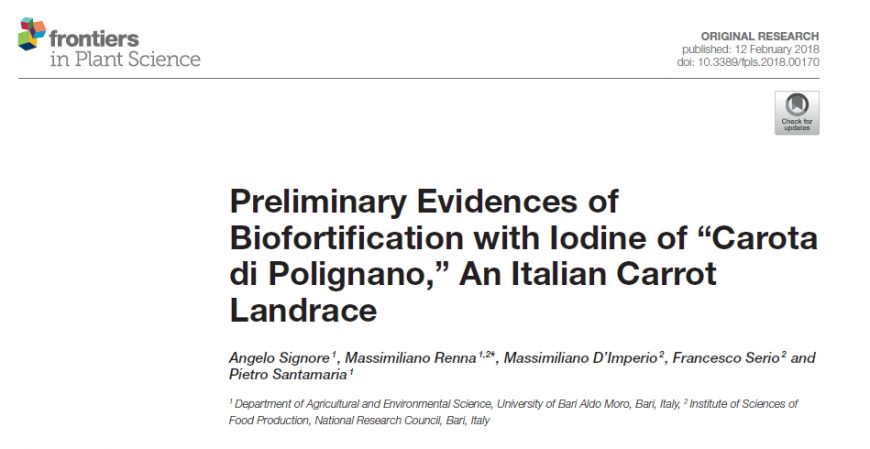
Articolo pubblicato sulla rivista Frontiers in Plant Science
Autori: Angelo Signore, Massimiliano Renna, Massimiliano D’Imperio, Francesco Serio, Pietro Santamaria.
ABSTRACT
The “Carota di Polignano” (Polignano Carrot – PC, Daucus carota L.) is a multi-colored landrace, cultivated in the Southern Italy, whose colors range from yellow to purple. Iodine is an essential micronutrient for humans, since it is a key component of thyroid hormones, which regulate the growth and development of the human body. The main source for iodine assumption is represented by diet, but its concentration in the vegetables is usually limited with respect to human needs. To this purpose, two experimental trials (in open field and in greenhouse with a soil-less system) were carried out to enrich PC with iodine. Three levels of iodine (control treatment, C – 0 mg·L−1; low, L – 50 mg·L−1; and high, H – 500 mg·L−1), distributed with foliar spray fertilizations (in both open field and greenhouse) or with nutrient solution (in greenhouse, at the level of 50 mg·L−1) in the form of KIO3 were compared. In open field, the H treatment showed a biofortification that was double and triple respect to L and C treatments, respectively, without influencing color and biometric parameters, such as the fresh and dry weight of roots and DM percentage. In greenhouse, the biofortification done with foliar spray fertilization followed the same trend of open field, while the biofortification by means of nutrient solution was more effective but reached very high levels that had toxic effects on the plants and could be too high for human nutrition. However, the concentrations of iodine into biofortified carrots in open field can allow to satisfy the recommended daily allowance (RDA) by consuming 100 and 200 g of fresh product for the treatment H and L, respectively. Regarding the greenhouse biofortification, the RDA would be satisfied by consuming 200 g of fresh carrots (with the high level of foliar fertilization).








